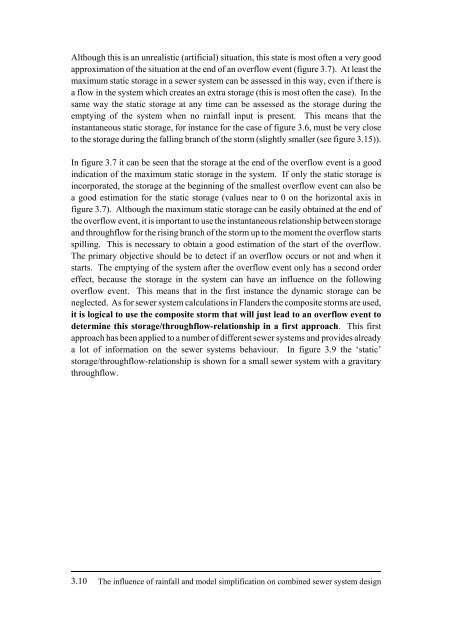Chapter 3 : Reservoir models - KU Leuven
Chapter 3 : Reservoir models - KU Leuven
Chapter 3 : Reservoir models - KU Leuven
You also want an ePaper? Increase the reach of your titles
YUMPU automatically turns print PDFs into web optimized ePapers that Google loves.
Although this is an unrealistic (artificial) situation, this state is most often a very good<br />
approximation of the situation at the end of an overflow event (figure 3.7). At least the<br />
maximum static storage in a sewer system can be assessed in this way, even if there is<br />
a flow in the system which creates an extra storage (this is most often the case). In the<br />
same way the static storage at any time can be assessed as the storage during the<br />
emptying of the system when no rainfall input is present. This means that the<br />
instantaneous static storage, for instance for the case of figure 3.6, must be very close<br />
to the storage during the falling branch of the storm (slightly smaller (see figure 3.15)).<br />
In figure 3.7 it can be seen that the storage at the end of the overflow event is a good<br />
indication of the maximum static storage in the system. If only the static storage is<br />
incorporated, the storage at the beginning of the smallest overflow event can also be<br />
a good estimation for the static storage (values near to 0 on the horizontal axis in<br />
figure 3.7). Although the maximum static storage can be easily obtained at the end of<br />
the overflow event, it is important to use the instantaneous relationship between storage<br />
and throughflow for the rising branch of the storm up to the moment the overflow starts<br />
spilling. This is necessary to obtain a good estimation of the start of the overflow.<br />
The primary objective should be to detect if an overflow occurs or not and when it<br />
starts. The emptying of the system after the overflow event only has a second order<br />
effect, because the storage in the system can have an influence on the following<br />
overflow event. This means that in the first instance the dynamic storage can be<br />
neglected. As for sewer system calculations in Flanders the composite storms are used,<br />
it is logical to use the composite storm that will just lead to an overflow event to<br />
determine this storage/throughflow-relationship in a first approach. This first<br />
approach has been applied to a number of different sewer systems and provides already<br />
a lot of information on the sewer systems behaviour. In figure 3.9 the ‘static’<br />
storage/throughflow-relationship is shown for a small sewer system with a gravitary<br />
throughflow.<br />
3.10<br />
The influence of rainfall and model simplification on combined sewer system design
















